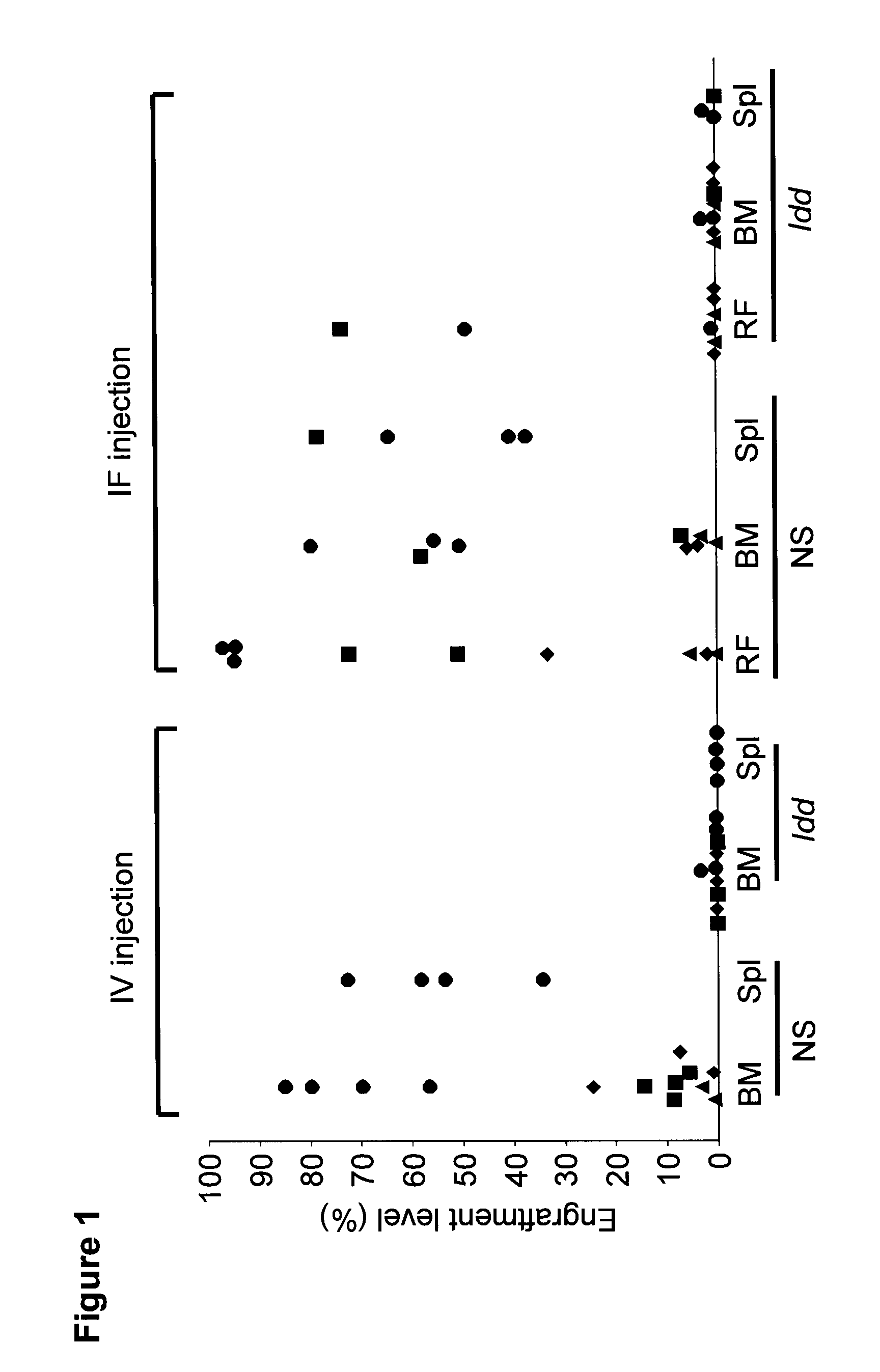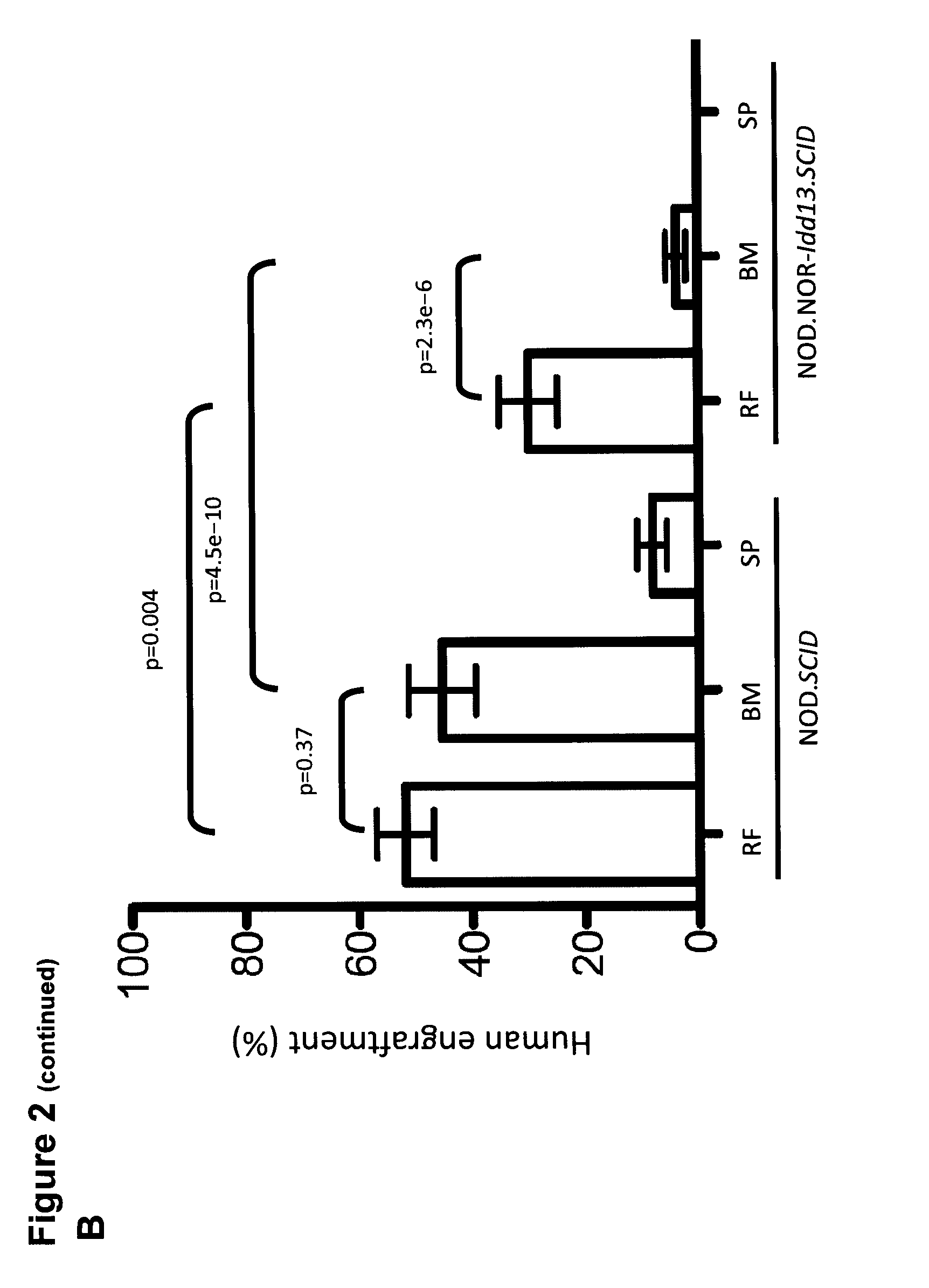Compositions and Methods for Treating Hematological Cancers Targeting the SIRPA CD47 Interaction
a technology of sirpa and cd47, which is applied in the direction of antibody medical ingredients, peptide/protein ingredients, drug compositions, etc., can solve the problem that little is known about the molecular regulators that govern the fate of aml-ls
- Summary
- Abstract
- Description
- Claims
- Application Information
AI Technical Summary
Benefits of technology
Problems solved by technology
Method used
Image
Examples
example 1
[0133]To investigate the relevance of CD47-SIRPα interaction in primary human AMLs, we transplanted primary cells from three AML patients intravenously (i.v.) into NOD.SCID and NOD.NOR-Idd13.SCID (Idd) mice. None of the AML samples could engraft the Idd mice while robust engraftment in the NOD.SCID mice was observed (FIG. 1), confirming the data obtained previously with normal human HSCs. When the same samples were transplanted intrafemorally (i.f.), 2 of 6 Idd mice showed engraftment in the injected femur but no engraftment in other bones or the spleen (FIG. 1).
example 2
[0134]We next performed i.f. transplants into mice pre-treated with antibody directed against murine CD122 which depletes host natural killer (NK) cells and some macrophages. Engraftment in the injected femur was observed for all 10 AML samples tested in NOD.SCID mice (43 / 43, 100%), and interestingly in 31 of 42 (74%) Idd mice (8 / 10 AML samples tested) (FIG. 2B), however the engraftment level was lower in Idd mice compared to NOD.SCID mice. In contrast to results obtained without anti-CD122 pre-treatment, engraftment in non-injected bones was detectable in 8 / 42 Idd mice (19%, 2 / 10 AML samples tested) while as expected most of the transplanted NOD.SCID mice supported migration (38 / 43, 88%, 10 / 10 AML samples tested). However the engraftment level in non-injected bones was significantly lower in Idd compared to NOD.SCID mice. Moreover, AML-LSCs were unable to repopulate the spleens of Idd mice. Homing assays performed with the best engrafting AML sample in this study revealed severe ho...
example 3
[0135]We studied the effect of mouse innate immunity on engraftment of human acute myeloid leukemia (AML) in mouse xenograft. FIG. 3A shows the modulation of natural killer (NK) cell and macrophage (Mφ) populations in NOD.SCID or NOD.NOR-Idd13.SCID. Surface phenotype of mouse NK cells and macrophages are indicated. Macrophages but not NK cells express Sirpα (left panels). Mice were treated with intraperitoneal (i.p.) injections of antibody against CD122 (expressed mainly on NK cells) or Clodronate. CD122 antibody treatment, which has been shown to improve engraftment of human hematopoietic cells in NOD.SCID mice, leads to rapid NK cell depletion but does not reduce mouse macrophages (upper right panel). Treatment with the bisphosphonate Clodronate leads to apoptosis and efficient depletion of macrophages (lower right panel of FIG. 3A).
[0136]FIG. 3B shows the engraftment of human AML cells in NOD.SCID or NOD.NOR-Idd13.SCID (Idd) after macrophage depletion. Sublethally irradiated mice...
PUM
| Property | Measurement | Unit |
|---|---|---|
| density | aaaaa | aaaaa |
| concentration | aaaaa | aaaaa |
| soluble | aaaaa | aaaaa |
Abstract
Description
Claims
Application Information
 Login to View More
Login to View More - R&D
- Intellectual Property
- Life Sciences
- Materials
- Tech Scout
- Unparalleled Data Quality
- Higher Quality Content
- 60% Fewer Hallucinations
Browse by: Latest US Patents, China's latest patents, Technical Efficacy Thesaurus, Application Domain, Technology Topic, Popular Technical Reports.
© 2025 PatSnap. All rights reserved.Legal|Privacy policy|Modern Slavery Act Transparency Statement|Sitemap|About US| Contact US: help@patsnap.com



